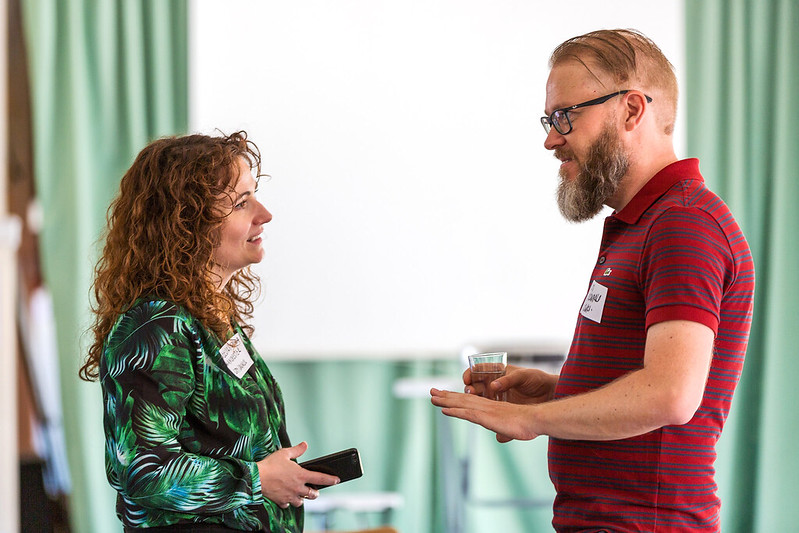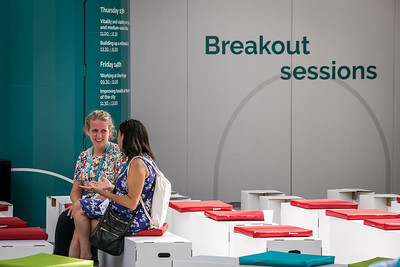While Valentine’s Day reminds us the importance of love in our lives, URBACT Action Planning Networks trigger good partnerships across EU cities willing to work together. For those aiming to submit an application for the open call for networks, read on for advice on how to find the best match and figure out the best way to seek out your ideal exchange and learning city partners.
Action Planning Networks bring together a number of city partners to collaborate over 2.5 years. Together they address a common urban challenge to develop long-term strategies and solutions to suit their local needs, the so-called Integrated Action Plans. The URBACT Programme specifies criteria about the composition and balance of these network partnerships.
In summary, each network proposal needs to have:
- from 8 to 10 partners, one municipality or local authority as a Lead Partner and the other institutions as Project Partners;
- a balanced partnership with cities coming from more developed, less developed and transition regions, in line with the EU Cohesion Policy;
- partners from the 27 EU member states, Norway, Switzerland Albania, Montenegro, Bosnia and Hezergovina, Bosnia and North Macedonia are all eligible for URBACT funds. Cities from other countries can also take part in networks at their own costs;
- the eligibility details are further described in the Terms of Reference for the call. In case of doubts, reach out to apn@urbact.eu.
So that already narrows the field... just a little. You now have the pick of hundreds of towns and cities across Europe!
What makes a good match?
It's important to take the time and effort to identify a great partnership at the application stage. In the context of the call (Terms of Reference, criterion 3), the quality and relevance of the partnership are highly valued, at 35% of the overall score to be more precise.
This is what the assessors will be looking for:
| 1. Relevant policy challenge for all | 6. Identified value of benefitting from the URBACT |
| 2. An appropriate geographical mix of EU Member States | 7. Relevant and diverse stakeholders to consolidate an URBACT Local Group |
| 3. Relevant strategic environment | 8. High potential for funding actions |
| 4. Links to the urban dimension of Cohesion Policy | 9. Relevant staff skills |
| 5. Willingness and ability to get involved | 10. Overall coherence |
Exploring potential partners
So, what does that mean in practice and how can you fulfil the criteria to be successful and create a great group for future collaboration?
In a change from the URBACT III (2014 – 2020) to the current programme period, networks will start with a full partnership from the beginning. In the past a reduced number of partners started the first six-months of the project (Phase 1) and expanded the partnership for the following two-year journey (Phase 2). Starting with a full partnership in URBACT IV means it's important to get the right partners in place at the application stage which will allow networks to go faster and quicker.
From our experience a vital element of productive partnership is a genuine shared interest and need around a particular challenge, whether that be mobility, digital transition or something else. Each partner also needs to bring a commitment to truly engage with all elements of the URBACT Programme. That means full participation in all meetings, openness and honesty, as well as willingness and enthusiasm to complete related tasks and support others. It means learning about the URBACT Method, building local capacity and integrating URBACT’s cross cutting themes of digital, green and gender equality into policymaking. Thinking about how much time and effort will be involved over the 2.5-year timeframe is key.
 The question of coherence and balance does not necessarily mean that all partners are similar or at the same stage of development. While some previous partnerships have been of similar cities, such as all capitals in ACCESS the metropolises in RiConnect; or all small and medium-sized cities in IPlace or ESIMEC; or even made of balanced structure, like in the Tropa Verde Transfer Network which counted with two boroughs/districts, two large cities and two agglomerations/metropolis.
The question of coherence and balance does not necessarily mean that all partners are similar or at the same stage of development. While some previous partnerships have been of similar cities, such as all capitals in ACCESS the metropolises in RiConnect; or all small and medium-sized cities in IPlace or ESIMEC; or even made of balanced structure, like in the Tropa Verde Transfer Network which counted with two boroughs/districts, two large cities and two agglomerations/metropolis.
But equally, we have seen successful partnerships with cities of different sizes, from different regional contexts, at different stages of development. In fact, the mutual learning does not go in a single direction, from “well-developed” to “less-developed” partners. There are always interesting insights to discover, through peer exchange and site visits, which promote reflection and innovative thinking. What matters is to demonstrate clearly the rationale of working in this formation, that the partners have a shared interest in the common challenge and have established this together before submitting the application.
To assist in this process a questionnaire for all potential partners is a useful way to collect the information that will be required to complete the application form, but also to assess what exactly the learning needs and potential contributions are, how each city partner wants to focus their local Integrated Action Plan. The criteria listed above would provide a good foundation. In addition, one to one or group calls are easy to set up to talk virtually and test the waters with each other. These are the kinds of questions that could be explored with more nuance in calls:
Do they have the right resources?
Can city partners commit the right kind of resource? Are they able to find the level of match funding? Can they allocate or hire the right staff to fulfil the local project roles? Do they have the finance team that can do the reporting on time and understand the audit control? Are they ready to set up and drive the local group and encourage local stakeholders to get involved at both local and transnational level? A good indicator is also the responsiveness of a potential partner at this stage already. If you are having to chase them then maybe that’s not a good omen.
Are they open to learning?
Do you get a sense that the city partners are hungry for new knowledge? Keen to learn and to honestly share their own experiences? What is their baseline level of understanding, for instance, of integrated and participated approaches?
Do they have political support?
It's really important that city partners will have political support in place. This is one of the known key barriers to implementation of Integrated Action Plans. It can also be quite destabilising or difficult administratively to lose a partner along the way if, for whatever reason, they withdraw from the network. How can prospective partners evidence that their political leaders are fully briefed and on board?
What exactly do they want to get out of participation in an URBACT Network?
It's good to tease out what exactly cities want from participating in URBACT. Is it money? Professional development? The chance to improve participative and integrated approaches? An opportunity to develop a plan that has more chance of securing EU and national funds? Make sure that partners understand what URBACT does and doesn't do and that they are applying to the right fund for the right reason.
Finding project partners

Where to find suitable candidates? The easy answer lies in URBACT’s Partner Search Tool. Although the platform might ignite many exchanges and allow people to have first contact with others, we are aware that many partnerships are done offline. URBACT events, notably the City Festivals, are a great way to get in touch with other cities and meet new peers.
Another way to get an overview of other proposals and opportunities is to reach out to the National URBACT Points. They are basically the programme’s ambassadors, who represent URBACT and communicate about it on a regular basis using local languages. To further disseminate information about the call, they have been organising National Infodays both in-person and online, which you are welcome to attend If, by any chance, you have missed the event, you can still contact your corresponding National URBACT Point.
Everlasting love?
URBACT partnerships last 2.5 years and often it's very hard to say goodbye at the end. But there are lots of examples of enduring friendships and spin off collaborations. There’s something incredibly rewarding and motivating about connecting with colleagues from other cities across Europe who do a similar job, who face similar challenges and are as focused on driving change.
Several networks or parts of networks have gone on in the past to work together in different shapes and sizes both within and beyond URBACT, for instance more than 30% of the URBACT III cities have applied to Horizon 2020 after the end of their network. The original Electric Vehicles in Urban Europe network went on to leverage the results into a multi-million Euro demonstration project through it.
Many cities have worked together through evolutions of URBACT Networks around tech and digital transition: from Techtown to TechRevolution and even a spin-off, the TechRevolution 2.0 Likewise, the original Action Planning Network PROCURE has later turned into the Transfer Network Making Spend Matter Both cases had many cities in common, including the same ones acting as Lead Partners.
In other cases, a specific theme was used as a common thread and as an occasion for cities to evolve and seek outnew directions. This was the case of AGRI-URBAN a network in which many partners moved towards Horizon 2020 opportunities, while other partners developed an URBACT Transfer Network, the BioCanteens counting with yet another spin-off, the BioCanteens 2 It’s worth mentioning that the Lead Partner of both BioCanteens’ networks was originally a new-comer Project Partner in AGRI-URBAN.
Some towns active in URBACT placemaking networks went on to deliver the Erasmus PART-Y project around gender sensitive youth services and participation. While a project partner from CREATIVE SPIRITS Implementation Networks has pursued its project with Urban Innovative Actions’ funds, the partners from the Re-growCities Transfer Networks founded a brand new project with EuroTowns. Most recently, some of the cities from the SibDev Action Planning Network had their bid for an Interreg Europe project approved.
 Hopefully these tips will help the right partners find each other to bid for URBACT funds. In the meantime, the Secretariat is here to help. Although it's not possible to provide an active matchmaking service, there are several resources to help you as you prepare your application, like all webinars and different materials. Just like love, cooperation knows no limits. But when it comes to the call for Action Planning Networks, don’t forget the deadline- 31 March.
Hopefully these tips will help the right partners find each other to bid for URBACT funds. In the meantime, the Secretariat is here to help. Although it's not possible to provide an active matchmaking service, there are several resources to help you as you prepare your application, like all webinars and different materials. Just like love, cooperation knows no limits. But when it comes to the call for Action Planning Networks, don’t forget the deadline- 31 March.


